Key takeaways:
- Gender equality advocacy is essential for fostering equal rights and opportunities; personal stories can shift perspectives and promote awareness.
- Intergenerational collaboration enriches advocacy efforts by combining diverse experiences and fostering a sense of community.
- Vulnerability and open communication in advocacy strengthen relationships and facilitate collective action.
- Sharing personal narratives creates empathy and inspires connection, driving a unified commitment to gender equality.
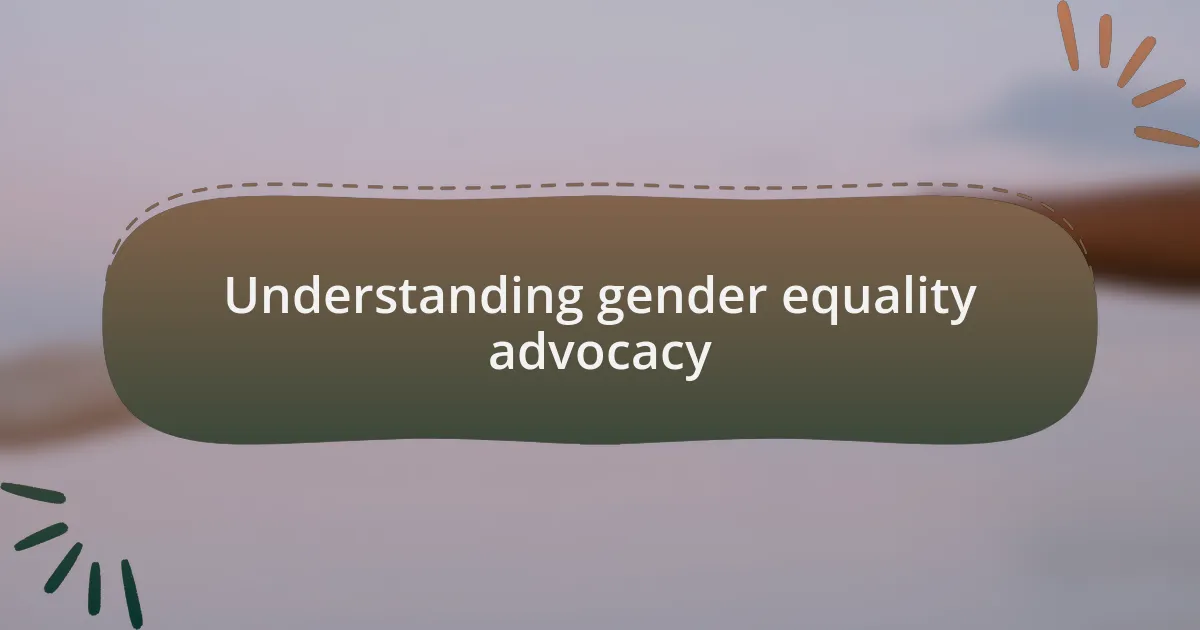
Understanding gender equality advocacy
Gender equality advocacy is a vital movement aimed at achieving equal rights and opportunities for all genders. From my experience, it is not just a lofty ideal; it resonates deeply with many people’s lives. I often reflect on the times I’ve witnessed gender bias firsthand, like when a female colleague’s ideas were overlooked in favor of less qualified male counterparts. It begs the question: how can we foster a culture that truly values everyone’s contributions?
As I navigated my own journey in advocating for gender equality, I realized that it’s about more than just highlighting disparities. It’s about creating a dialogue that encourages awareness and understanding. I remember a conversation I had with a friend who initially didn’t grasp the importance of this issue. Through sharing personal stories, I saw their perspective shift, emphasizing that advocacy often starts with individual narratives.
The emotional weight of gender inequality cannot be overstated; it affects not only individual lives but entire families and communities. Have you ever considered how breaking these barriers could create a ripple effect? I often think about the young girls who hesitate to pursue their dreams due to societal limitations. This encapsulates why gender equality advocacy is crucial—it has the power to reshape futures, sparking transformation at every level of society.
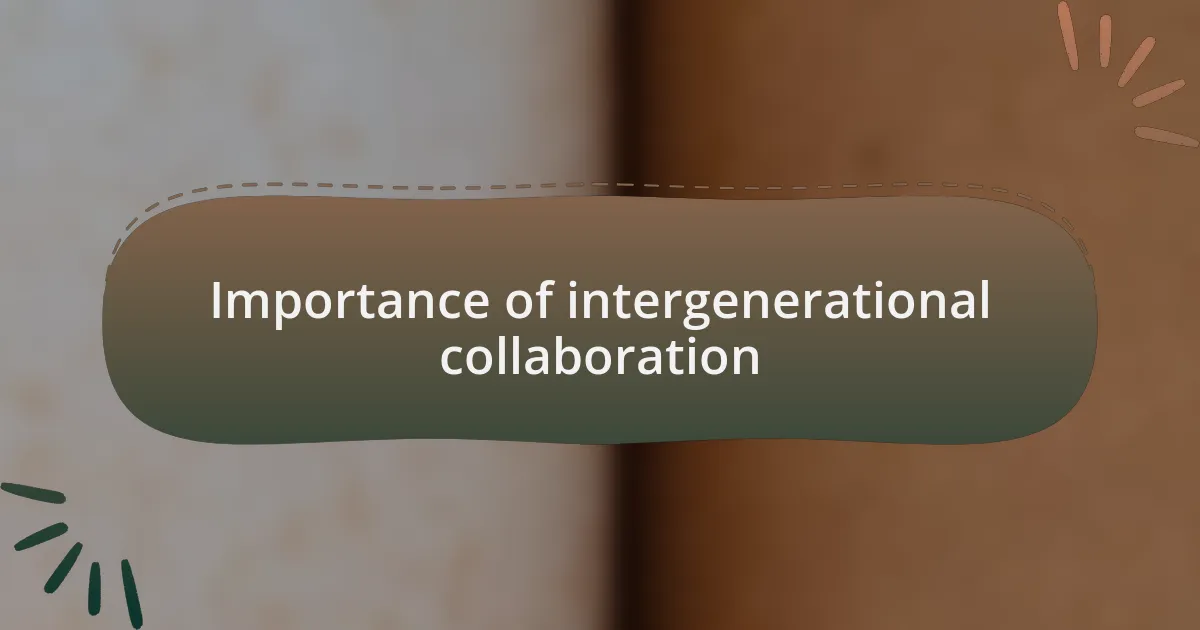
Importance of intergenerational collaboration
Engaging in intergenerational collaboration brings together diverse perspectives, fostering a richer understanding of gender issues. I vividly recall a workshop where younger activists partnered with seasoned advocates. The exchange of ideas illuminated how experiences from different eras can inform and strengthen our advocacy efforts today. Have you ever noticed how a fresh viewpoint can breathe new life into challenging discussions?
Moreover, I’ve realized that bridging generational gaps creates a sense of community and shared purpose. For instance, a mentor of mine, who fought for female representation decades ago, shared her strategies while encouraging my peers and me to find innovative solutions for our time. This blend of wisdom and youthful energy not only empowers the movement but also cultivates a legacy of resilience.
Ultimately, intergenerational collaboration enhances the effectiveness of gender equality advocacy. It encourages mutual respect and understanding, allowing us to build on the foundations laid by previous generations. This partnership reminds us that our fight is not just for our generation; it is for all those who will come after us. How can we ensure that the lessons learned are not lost but instead passed down?
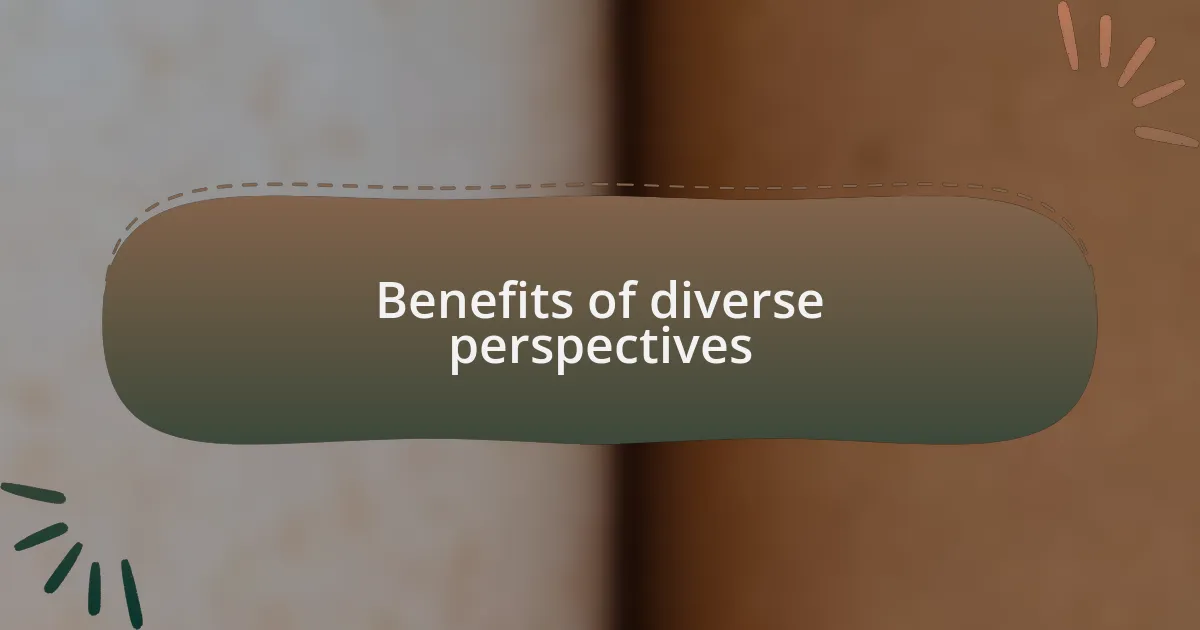
Benefits of diverse perspectives
Diverse perspectives foster innovative solutions that simply wouldn’t emerge in a homogeneous group. I remember a brainstorming session where younger activists proposed ideas that seemed unconventional, yet they resonated deeply with our mission. The older members brought historical context, helping us see how these ‘out-of-the-box’ thoughts could align with solid strategies from the past. Isn’t it fascinating how a blend of new and old can spark something entirely unique?
Considering the emotional landscape of gender advocacy, it’s clear that varied experiences enhance empathy and understanding. For instance, while strategizing over an initiative, I was moved by the stories shared by a retiree who faced structural barriers we hardly encounter today. This exchange not only deepened my appreciation for the struggles endured but also ignited a collective determination to challenge the remaining issues. How can we not feel empowered when we stand on the shoulders of those who made sacrifices?
Engaging with different viewpoints encourages critical thinking and challenges our assumptions. During a panel discussion, I was surprised when a younger participant posed a question about inclusivity that made us all reconsider our approach. That moment taught me that every voice matters, and sometimes, the most profound insights come from questioning the status quo. Have you ever had an experience that turned your understanding upside down?

Strategies for effective collaboration
To foster effective collaboration, it’s important to establish open communication channels where everyone feels heard. I recall a working group meeting where I advocated for regular check-ins, which allowed us to share progress and address concerns collaboratively. This approach created a sense of ownership among all team members, making each voice feel valued. Have you ever experienced how small adjustments in communication can transform the atmosphere?
Another strategy is to set shared goals that resonate across generations. I once facilitated a workshop focused on aligning our efforts towards a common objective. The harmonization of the younger and older generations’ visions energized the group, fostering a sense of unity that propelled our initiatives forward. Isn’t it incredible how a shared purpose can bridge gaps and strengthen bonds?
Lastly, investing time in relationship-building activities can enhance trust, which is essential for successful collaboration. I remember participating in informal gatherings that allowed us to connect on a personal level, breaking down barriers that often hinder collaborative efforts. These moments of camaraderie not only enhanced our teamwork but also made difficult conversations more manageable. What experiences have you had that strengthened your relationships in collaborative projects?
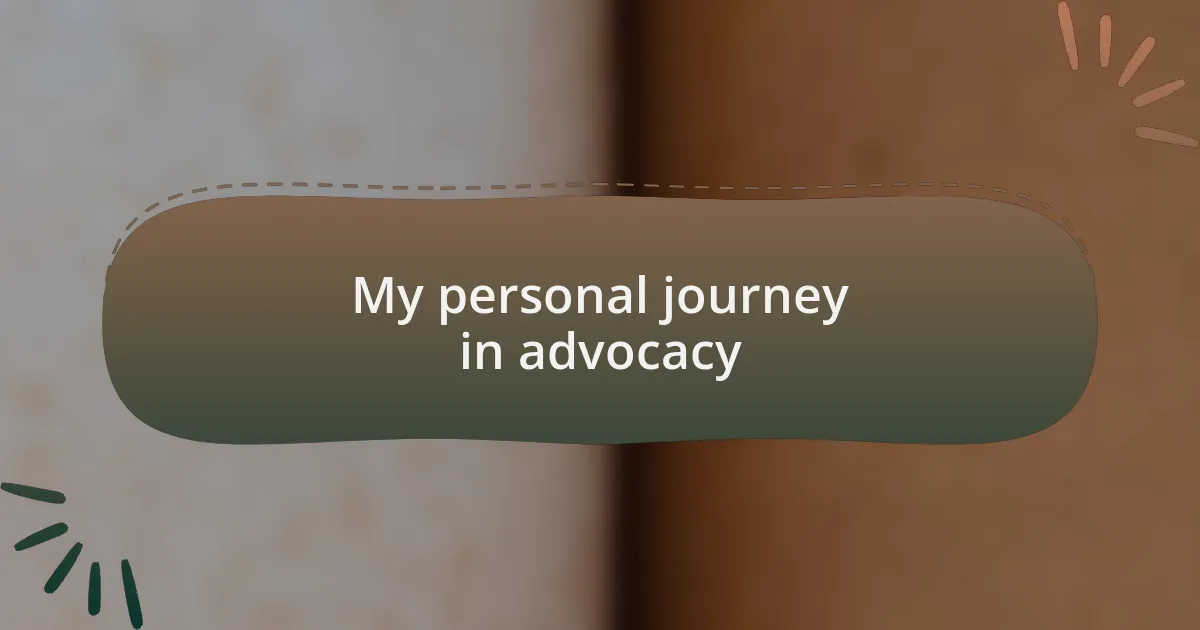
My personal journey in advocacy
As I embarked on my advocacy journey, I quickly learned the power of mentorship. I remember my first encounter with a seasoned advocate who took the time to guide me through the intricacies of gender equality work. This relationship not only shaped my understanding but also fueled my passion; could there be a more profound gift than the wisdom passed down through generations?
Reflecting on early challenges, I vividly recall a critical moment when my ideas were met with skepticism in a mixed-age team. Instead of feeling defeated, I chose to share my personal experiences related to gender inequality, which resonated deeply with both younger and older colleagues. It struck me how our shared experiences, despite the generational gap, could spark empathy and understanding. Have you ever felt that connection with someone from a different generation in a shared cause?
Over time, I’ve realized that vulnerability is a strength in advocacy. I distinctly remember sharing my struggles during a community meeting, which opened the floor for others to share their own journeys. That day, a beautiful mosaic of stories emerged, illuminating the varied yet interconnected nature of our experiences. Isn’t it fascinating how openness can forge powerful connections and inspire collective action?
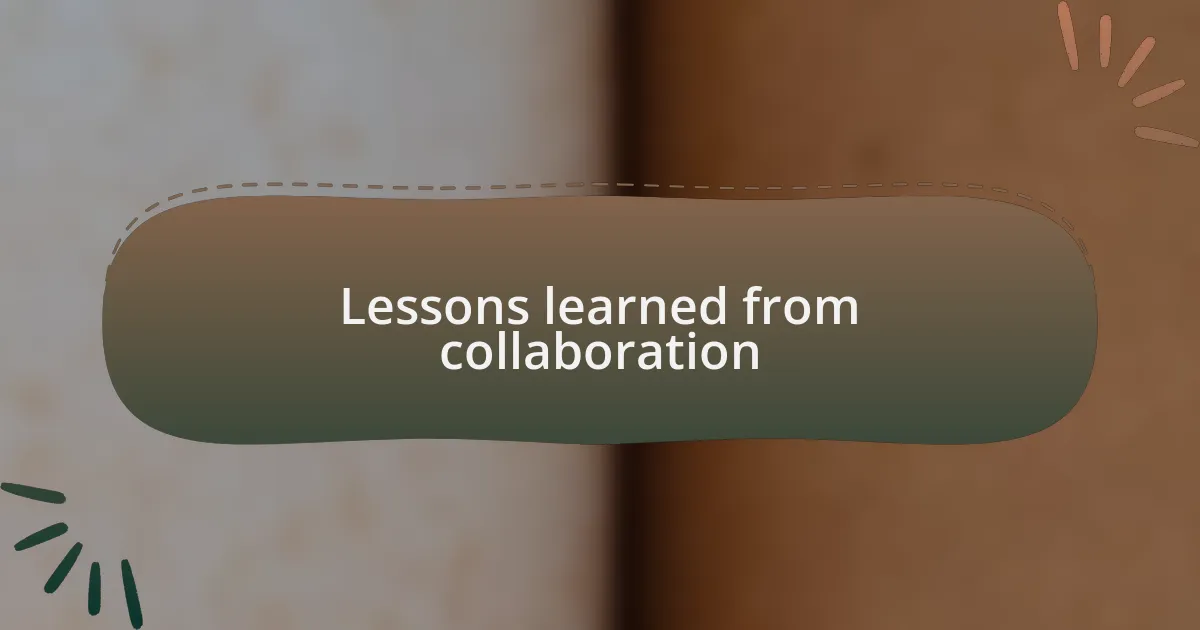
Lessons learned from collaboration
Collaboration across generations has taught me the importance of embracing diverse perspectives. During a recent project, I found myself brainstorming with a younger teammate who had fresh, innovative ideas. Their enthusiasm reminded me of my early days, reigniting my creative spirit and showcasing how intergenerational dialogue can breathe new life into established approaches. Have you ever discovered new inspiration from someone who views the world differently than you?
One of the most profound lessons I’ve learned is that patience is vital in collaborative efforts. I recall a time when conflict arose over differing priorities within our team. Instead of rushing to a resolution, we took a step back and engaged in open discussions, allowing each voice to be heard. This patience not only deepened our understanding but also transformed a potential rift into a shared vision for success. Isn’t it incredible how taking the time to listen can lead to stronger, more united outcomes?
Through collaboration, I’ve also come to appreciate the value of collective resilience. I remember a challenging campaign where setbacks seemed inevitable. Rather than allowing frustration to take hold, our team rallied around our shared goal, encouraging one another to persist. In those moments, I felt empowered, realizing that, together, we could overcome obstacles that may have seemed insurmountable individually. How often do we forget that our strength lies in unity?
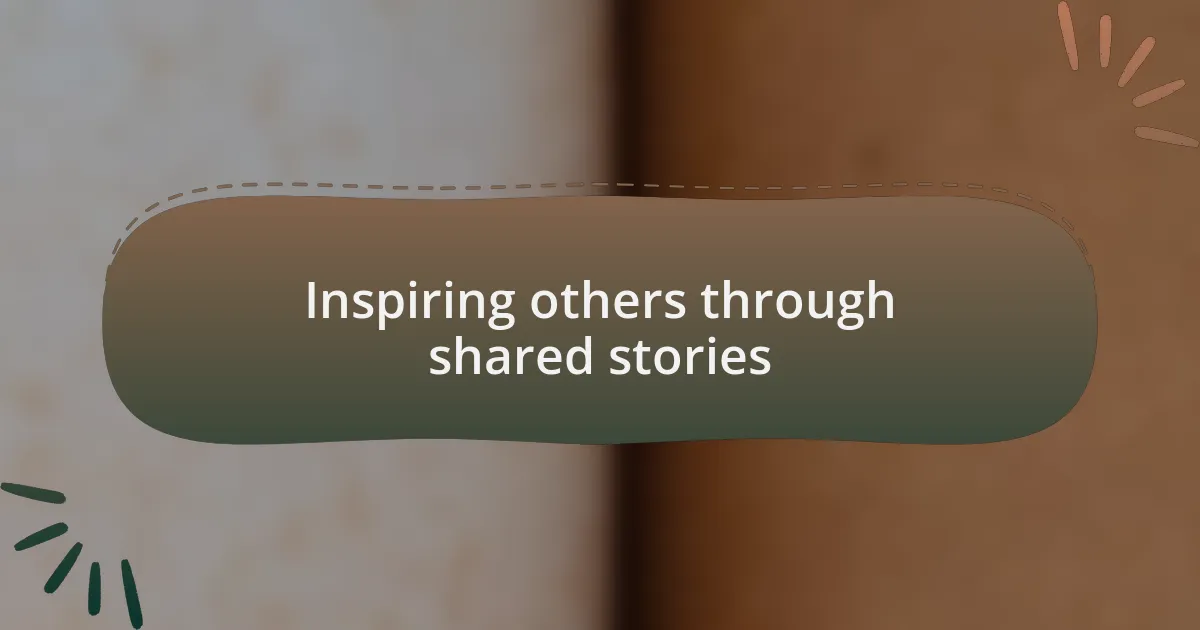
Inspiring others through shared stories
Sharing stories has a remarkable power to inspire and connect individuals from different generations. I remember a meeting where a younger colleague shared her experiences navigating workplace challenges as a woman of color. Her narrative struck a chord with me, reminding me of similar struggles I faced early in my career. Hearing her story awakened a deeper empathy in my own journey, demonstrating how our experiences can bridge gaps across age and background, ultimately igniting passion for change.
When I reflect on the profound impact of shared stories, I think about a mentorship program I participated in. A young man courageously shared his family’s history with gender inequality, demonstrating how it influenced his aspirations. His vulnerability opened up a rich dialogue, enabling other participants to share their own stories and heartaches. That’s the beauty of storytelling: it lays the groundwork for authenticity and connection, prompting us to support one another in striving for equality. How often do we stop to reflect on the stories that define us?
The stories we share can create ripples of inspiration beyond our immediate circles. I recently hosted a panel discussion where a seasoned advocate and a fresh activist spoke about their distinct journeys toward gender equality. Their contrasting yet complementary narratives not only resonated with the audience but also sparked actionable discussions on how we can all contribute. Isn’t it fascinating how our individual tales can interweave, enhancing our collective understanding and commitment to a common cause?